BSD High Power Rocketry Diab-Glo
BSD High Power Rocketry - Diab-Glo {Kit}
Contributed by Steve Jurvetson
| Construction Rating: | starstarstarstarstar |
| Flight Rating: | starstarstarstarstar |
| Overall Rating: | starstarstarstarstar |
| Manufacturer: | BSD High Power Rocketry  |
Brief:
The BSD Diab-Glo is a single stage specialty night launch rocket festooned with multi-color blinking LEDs and
parachute recovery.
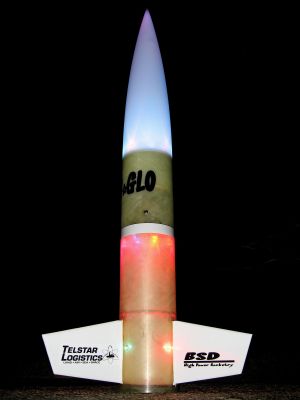
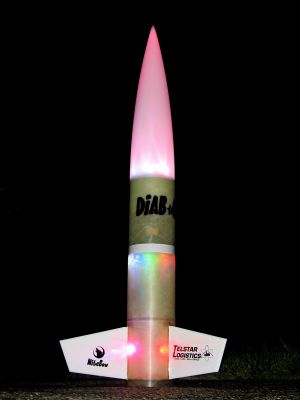
Construction:
One clear fiberglass 4” body tube. Transparent nose cone with U-bolt attachment. Three ¼” wood fins.
Wood centering rings and bulkheads plus one transparent plexiglass centering ring for internal light passage.
38mm motor tube. As a stubby rocket with most of the internal space dedicated to lighting, the longest possible motor that can fly in this kit is the AMW 38/390. Packing the chute is a bit easier with the Aerotech 38/360 motor size.
Designed to be a night launch rocket kit, the Diab-Glo uses high powered LEDs pointing up into the nose cone, down through the clear fiberglass airframe, and pointing out along each fin surface. The pre-wired LEDs automatically rotate through red, blue and green colors and all colors in-between in a dance of bright, blinky lights.
Fantastic instructions and diagrams-–one of the best documents I have seen.
Special tools needed for the build:
- Soldering iron. The soldering is quite easy. You should have no trouble with this even if you have never used one before.
- I would also recommend a Dremel tool for cutting the fin slots in the fiberglass airframe. Using an X-Acto knife could be quite an effort.
- Drill for LED holes. If you have an older dull drill bit, it will do less damage to the fiberglass. I got some chips on the edges that were easily repaired during the epoxy step.
- I also recommend a clear epoxy (since so many surfaces are meant to remain unpainted. I had great results with Devcon 2-ton clear epoxy.
- Reflective silver tape is a nice item to add to the inner tube. It makes it even brighter.
This was a fun and easy build. I am very impressed with the overall design, as it is quite unique and clever in the way it maximizes light output in all directions. The only "gotcha" I found (and future instruction versions might fix this): My fins were 4" long and the instructions said to cut a 4.5" slot, so check the fin length versus the instructions before cutting the fin slots.
Finishing:
Nice vinyl decals included. Only the fins need painting white.
Construction Rating: 5 out of 5
Flight:
BSD recommends the G64, H128, H123, H242, I161, I357, or I220.
I had a perfect maiden launch with an Aerotech I218 Redline with L motor delay.
After motor burnout, she soared silently up, separated into two sections, and deployed a satin white parachute at apogee. The two blinking sections spun tethered together like two dancers embraced in a delirious spiral across the Milky Way.
AMW I285 Green Gorilla Launch at XPRS. Another beautiful flight, but the BP did not ignite (motor issue, not a kit issue). The kit is so strong that a ballistic return to the Black Rock desert playa only destroyed the nose cone. The body lights were still blinking and the airframe did not even have a scratch on it! With a new nose cone, it's ready to fly again. Wow.
I used a GLR Kevlar® chute protector with the 36/360 but I had to use a smaller one for the 36/390 motor. There is so little room for the chute that I had to roll it into a ring and let the nose cone ride on top of it (leaving a cm gap on the nose cone fit, however, the rocket flies fine with the nose cone jutting out a little bit).
I used the included clamps for retention, but they were not easy to install near enough to the motor. I had to bend the metal screw receptors to get them close enough to the motor tube. Normally I like to fly the bell-shaped 38mm motor retainer from GLR. I will add one to the kit now because it will work with the AMW motor I want to fly. (Although the GLR website says it will not work, I have not flown that yet but it seems fine in a test fit.)
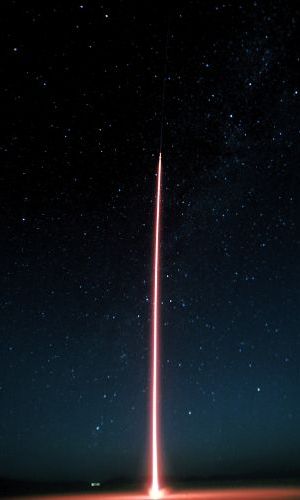
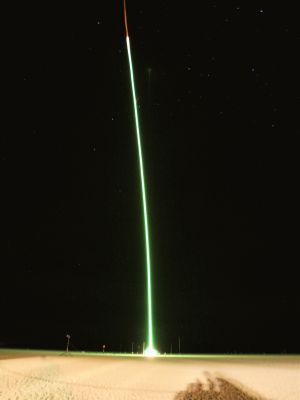
Recovery:
Beautiful white satin parachute looks wonderful in the night sky. Kevlar®
cord attaches to a longer shock cord. The Kevlar®
cord looks a bit light to me. After two launches, it is looking a bit worn and I'm not sure how much more it can take.
The construction method makes it impossible to replace. All of the thrust and parachute connection forces are borne by
the glue around the 38mm motor tube rings, deeply embedded in the rocket innards.
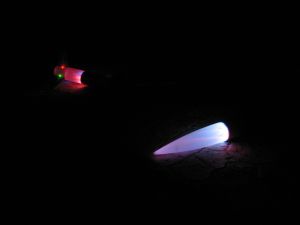

Flight Rating: 5 out of 5
Summary:
PROs: It is the most over-the-top blinky rocket per square cm of body surface that I have ever seen. At XPRS 2007, it
generated audible "oohs" and "aahs" from everyone I passed on the walk to the RSO table. This kit
has made night launches my favorite rocketry activity.
CONs: Very little room for parachute and chute protector with the I motors. An extra inch or two on the airframe would make all the difference. I would like to add a flight computer. I have yet to see how easy that is.
Overall Rating: 5 out of 5
 |
 |